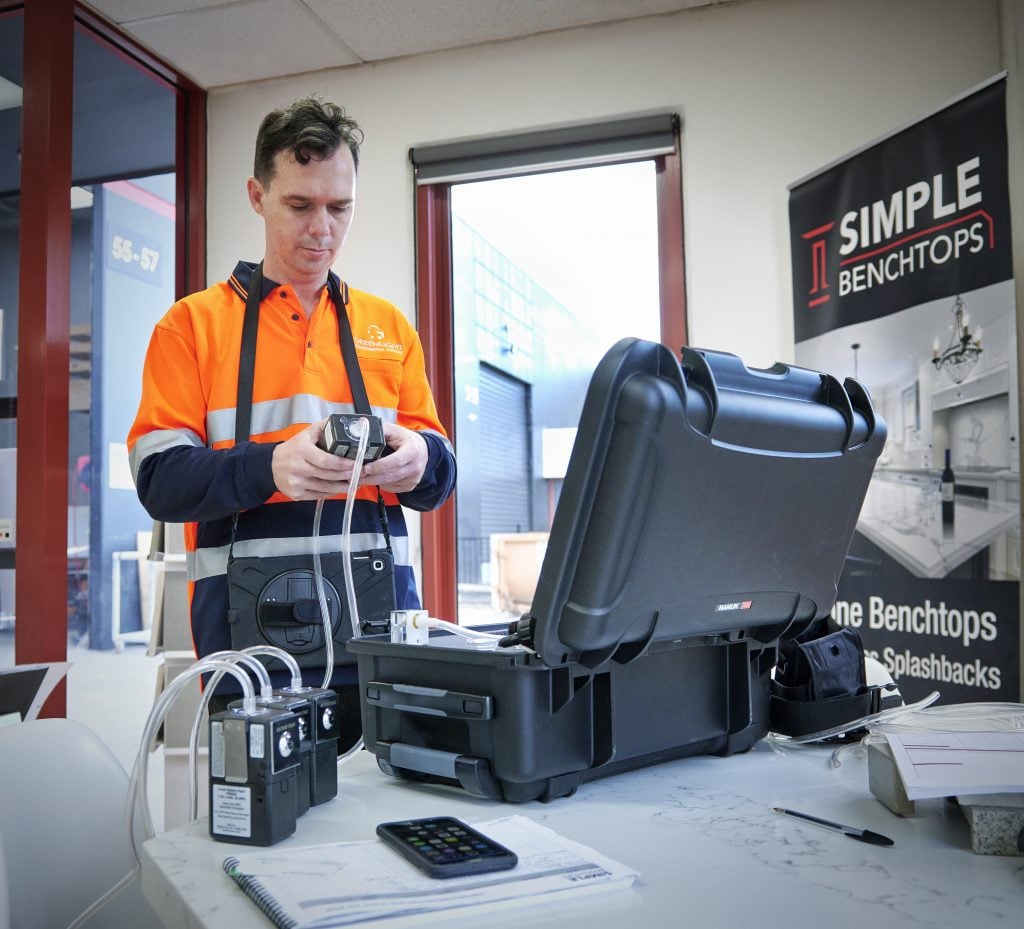Your Most Common Questions About Silica Dust and Silicosis Answered

Over the last few years, the term Silica has become quite prevalent, particularly in the building and construction industry.
Sometimes described as the “new asbestos”, Silica or more specifically, Silica dust, has been recognised as a serious risk to the health of those who are exposed to it.
So, who is at risk of Silica dust exposure, and what does that mean? Keep reading to learn more about Silica, the risks associated and what you can do to maintain your own safety.
1. What is Silica?
Also know as silicon dioxide, Silica is a naturally occurring mineral that is a major component of rocks, sand, stones, and soils. It can often be found in manmade building materials like bricks, tiles, concrete, mortar, and engineered stone.
It is a very durable and stable element and exists in non-Crystalline and Crystalline forms. Of these types of Silica, it’s Crystalline that poses the biggest health risk.
2. What is Crystalline Silica?
The most common type of Crystalline Silica is Quartz, though there are many different kinds.
As quartz is both abundant and highly durable, it is commonly used widely throughout the building and construction industry in many different ways.
When Crystalline Silica is solid and undisturbed, it is not considered a hazard.

3. What do we mean by disturbing Crystalline Silica?
Essentially, when Crystalline Silica is disturbed, very small particles of dust, known as Respirable Crystalline Silica, are created. It’s these particles that are hazardous as they can get into your lungs and actually penetrate deep into the lung tissue and stay there. Repeated exposure to these particles can lead to both short term and long-term health issues.
4. How is Silica Dust created?
Silica dust or the Respirable Crystalline Silica can be created through a variety of different activities that disturb the materials or products that contain Crystalline Silica.
Some of the materials that contain Crystalline Silica include brick, cement, concrete, grout, mortar, sand, stone, tile, drywall, asphalt, rock/stone, and engineered stone, such as those created for benchtops and flooring.
Some Silica dust generating activities include:
- Abrasive blasting
- Cutting
- Chipping
- Coring
- Drilling
- Grinding
- Jackhammering
- Milling
- Mining
- Mixing
- Polishing
- Sanding
- Sawing
- Scraping
Keep in mind that these are some of the most common Silica dust generating activities.
5. What is dangerous about Silica dust?
Silica dust, or Respirable Crystalline Silica (RCS), has been found to have both long term and short-term negative health impacts. But before we talk about what those health impacts are, let’s talk a little bit more about the dust.
Respirable Crystalline Silica is very fine, and the particles on their own are not visible to the naked eye. That’s not to say you can’t see Silica Dust. In the process of creating the dust through any of the actions above, as many particles are usually being created at the same time, you may be able to see the dust in the air or piles of it on the ground for example.
However, as the particles are very fine, it’s not always possible to tell if they are present in the air, which means you could potentially be inhaling them. Due to their small size, RCS particles are able to make their way into the alveolar tissue, which is in the deepest parts of the lungs. This can lead to a number of different respiratory system issues.
6. What illnesses can be caused by breathing in Silica dust?
Silica exposure can lead to the development of the following conditions:
- Chronic Bronchitis
- Emphysema
- Kidney Damage
- Lung Cancer
- Rheumatoid Arthritis
- Scleroderma
- Silicosis
These health conditions are serious, and in some cases incurable.
7. What is Silicosis?
Silicosis is an irreversible and disabling occupational disease that is one of the biggest health risks for workers who are exposed to Respirable Crystalline Silica.
In cases of silicosis, lung tissue has become scarred from exposure to the Silica dust particles. The scarring is caused by the body’s attempt to remove the Silica particles.
As the particles are so small, they can easily find their way into the deeper lung tissues. Normally, when we breath in dust, our lungs try to remove it through coughing or even bringing up phlegm. However, as Silica dust can get so far into the lung tissue, we aren’t always able to remove the dust through our normal means. So, then the body tries to remove them by dissolving them.
Our cells try to engulf the particles; however, our immune system cells cannot actually dissolve the Silica particles, which leads to the cells dying, which is what causes the scarring of the lungs.
Through repeated or high levels of exposure to Silica dust particles this process can continue, which can lead to difficulties breathing and absorbing oxygen, which can result in death.
8. Are there different kinds of silicosis?
Yes – there are 3 types of silicosis: Acute Silicosis, Accelerated Silicosis and Chronic Silicosis.
Acute silicosis is a result of a large amount of exposure to Silica over a short period (less than a year) and is rare.
Accelerated Silicosis is caused by large amounts of exposure to Silica over a short period that is greater than a year, less than 10 years. This is now becoming more common, particularly amongst stone benchtop workers.
Chronis Silicosis is a result of levels of Silica exposure, over a period of more than 10 years.
In many instances, those who are in the early stages of any kind of silicosis are unaware that they may be unwell as many symptoms do not present until there is more damage to the lungs.
Common symptoms that can occur include:
- Coughing
- Shortness of breath
- Fatigue
- Occasional Chest Pain
- Loss of Appetite
While there is no cure for silicosis, it is preventable.
9. Who is at risk of getting silicosis?
People working in various areas of the building and construction industry are at the highest risk of developing silicosis.
Some of the activities and workers who are at a higher risk of Silica dust exposure include:
- Stone Masonry – particularly significant for those who work with the creation and installation of stone countertops. This can be both natural and engineered stonework.
- Stone, Brick or Concrete cutting, particularly those who use a dry method.
- Mining and Quarry workers exposed to mineral ore treating processes.
- Excavation, tunnelling, and earth moving operations.
- Abrasive blasting.
- Foundry and Sand Casting.
- Labouring and Construction Activities.
- Paving and Surfacing work.
- Concrete or Masonry grinding, jack hammering and chiselling.
- Clay and stone processing machine operations.
10. How do I reduce my chances of being exposed to Respirable Crystalline Silica?
In Australia, it is a Workplace Health & Safety Regulation that workers who may be using, handling, generating, or storing hazardous materials, such as Silica Dust, have appropriate controls in place to manage and reduce their risks of exposure to these materials.
If your workplace regularly uses Crystalline Silica or potentially has Silica dust, there should be protective gear, as well as appropriate tools, materials, and processes in place to help to prevent the dust from becoming airborne.
Another important step of reducing your exposure to Respirable Crystalline Silica is understanding the actual Silica exposure levels that may be occurring at your workplace. This can be done through professional Silica Monitoring and Testing services.

11. What is Silica Monitoring?
Silica monitoring involves a thorough examination of a workplace to ensure that the presence of Silica dust doesn’t exceed the Workplace Health & Safety Regulations Respirable Crystalline Silica Exposure standards.
Usually this will involve a number of different steps, including:
- An inspection of the workplace. The workplace can be anywhere where Crystalline Silica is being used, such as a residential site, office building, warehouse etc.
- The monitoring of exposure levels to workers through all processes that Crystalline Silica is used in
- Sample collection of materials
- Testing of collected samples in a NATA accredited laboratory.
- Air monitoring of the workplace
- Reporting of all potential risks to your workplace.
12. What are the workplace exposure standards for Silica Dust?
The standards of exposure require that a worker is not to be exposed to more than 0.05mg/m3 of Silica dust in their breathing zone over an 8-hour period. These levels have been determined through epidemiological and toxicological data.
WorkSafe Victoria does recommend a precautionary approach and reduce employees’ exposure to below 0.02 mg/m3 as an 8-hour TWA.
In addition to these exposure levels, workers who work handling, using, generating, or storing Crystalline Silica on an ongoing basis must have their health monitored. The health monitoring includes collection medical history information, standardised respiratory questionnaires and tests, and records must be kept of exposure.
By law, employers must carry out air monitoring if they are not sure if the exposure levels to silica dust are above the exposure standard or if they are unable able to work out if there is a risk to employee health without this air monitoring. Ongoing air monitoring will need to be conducted to ensure the exposure standard is not being exceeded and must occur at least once every six months.
13. Who can help understand the risk of exposure to Respirable Crystalline Dust at my workplace?
If your workplace uses materials that may contain Crystalline Silica, or undertakes processes where Silica dust is created, it is vital that steps are taken to minimise the risk of exposure for all workers.
Silicosis and the other illnesses that can be caused by exposure to Silica dust are preventable when the right precautions are taken.
This is where we can help you. At Greenlight, we offer a Silica testing and monitoring service where we can help you understand the risks of Silica dust exposure at your workplace.
Our comprehensive service means we can help to not only identify the risks present but also help you to manage them safely and effectively.
We provide our Silica monitoring and testing service in Melbourne and Victoria in all sorts of work environments, so if your business works with Crystalline Silica, give us a call today on 03 9048 4411.

Melbourne Based OHS Consultancy | Hazard Identification & Management
Book Your Onsite Inspection NowRecent Posts

A Homeowner’s Guide to Asbestos in Houses
View Post »
Greenlight on 3AW
View Post »

